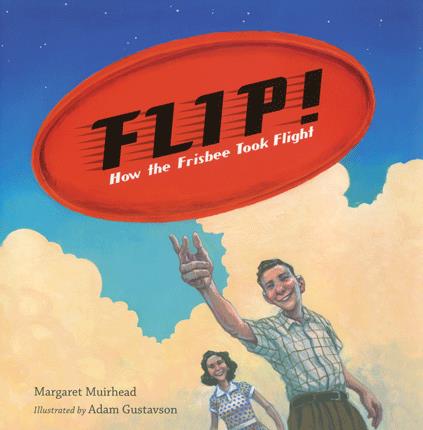| Flip! : how the frisbee took flight Author: Muirhead, Margaret | ||
| Price: $23.08 | ||
Summary:
Fred Morrison is credited with inventing this classic toy, but for centuries folks have been flipping for flying discs. For more than twenty years, Fred and his wife, Lu, tried and failed to perfect a flying-disc concept. Eventually they created what we know today as the Frisbee.
| Illustrator: | Gustavson, Adam |
| Accelerated Reader Information: Interest Level: LG Reading Level: 4.40 Points: .5 Quiz: 514126 |
Reviews:
Kirkus Reviews (04/01/21)
School Library Journal (00/05/21)
Booklist (04/01/21)
The Bulletin of the Center for Children's Books (00/03/21)
Full Text Reviews:
Booklist - 04/01/2021 While most books on inventors tell relatively straightforward stories, Muirhead searched for the originator of the Frisbee and found multiple answers. Students at certain New England colleges and universities started tossing upside-down Frisbie-brand pie tins in the 1920s. Those institutions, which proudly claim bragging rights, are mentioned in this book. But Fred Morrison stands in the spotlight, initially as a California high-school student tossing a popcorn-can lid in 1937 to Lu, his future wife and unwavering supporter. After WWII, he attempted to sell a plastic disc that sometimes shattered, and then an improved model that worked well. And when the Wham-O company bought his design, modified it, and renamed it, the Frisbee really took off. Writing with an informal, amiable tone, Muirhead portrays Morrison as a man with a practical approach and an unwavering enthusiasm for his flying disc. Gustavson’s gouache paintings help viewers imagine bygone eras, while his lively depiction of individuals gives each one a distinctive look. This inviting picture book introduces Fred Morrison as the resourceful, persistent man behind the Frisbee. - Copyright 2021 Booklist.
School Library Journal - 05/01/2021 K-Gr 2—The frisbee is such a ubiquitous toy, it is hard to imagine a time when it didn't exist. This nonfiction picture book tells the story of the origin and marketing of the classic toy. After a brief mention of older disc games (like those in Ancient Greece), the book begins exploring the creation of the frisbee almost simultaneously in two places in early-20th century America—Yale University and California beaches. Told in narrative text and colorful drawn illustrations, the frisbee evolves from a pastry dish to a plastic saucer and the toy we know now. The colorful cartoon-like drawings well match the subject matter. The elongated arms of the disc-throwing people especially suggests the sense of movement. Other than a brief author's note at the end and a short list of sources, there is no additional back matter or historical information. No photos are included to provide more context. While this will be good as a story for young students, it will not be sufficient for older students doing research. VERDICT A sweet nonfiction picture book explaining the history of the frisbee which might be of interest to young students but lacks any additional depth for further learning.—Elizabeth Nicolai, Anchorage P.L., AK - Copyright 2021 Publishers Weekly, Library Journal and/or School Library Journal used with permission.



